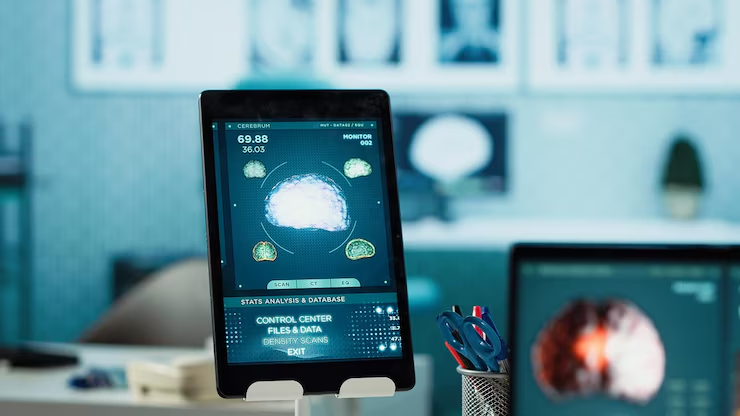
Brain-computer interfaces (BCI) are devices that create a direct communication pathway between a brain’s electrical activity and an external output. Their sensors capture electrophysiological signals transmitted between the brain’s neurons and relay that information to an external source, like a computer or a robotic limb, which essentially lets a person turn their thoughts into actions.
These brain chips go over the scalp in a wearable device, get surgically placed under the scalp or even get implanted within brain tissue. The idea is that, the closer the chip is to the brain’s neural network, the more clear, or “high definition,” a signal can be interpreted.
Brain-Computer Interface Definition
A brain-computer interface (BCI) is a device that lets the human brain communicate with and control external software or hardware, like a computer or robotic limb.
Perhaps the most popular example of a brain-computer interface is Neuralink, a chip that was implanted into a quadriplegic patient’s brain in 2024 and allows him to control a computer.
What Is a Brain-Computer Interface?
Brain-computer interfaces are devices that process brain activity and send signals to external software, allowing a user to control devices with their thoughts.
With BCI technology, scientists envision a day when patients with paralysis, muscle atrophy and other conditions could regain motor functions. Rehabilitation services could also adopt BCIs to accelerate recovery from injuries.
Ramses Alcaide, CEO of neurotech startup Neurable, which develops non-invasive brain-computer interfaces in the form of headphones, sees potential for BCI-enhanced devices to become an everyday item for the average person.
“If we can make brain-computer interfaces accessible and seamless enough then they can be integrated into our daily lives, just as we use smartphones or laptops today,” Alcaide told Built In. “But in order to truly become a ubiquitous tool, they need to be comfortable, intuitive and reliable enough that people can use them without consciously thinking about them — similar to how we use a mouse or keyboard to interact with a computer.”
How Do Brain-Computer Interfaces Work?
Brain-computer interfaces are modeled after the electrophysiology of a brain’s neural network. When we make a decision — or even think about making a decision — electrical chemical signals spark. This phenomenon is located in our nervous system; more specifically, in the gaps between neurons, known as synapses, as they communicate back and forth.
In order to capture this brain activity, BCIs place electrodes proximal to these conversations. These sensors detect voltages, measuring the frequency and intensity of each “spike” as they fire or potentially fire.
“It’s like a microphone; but in this case, we’re listening to electrical activity instead of sound,” said Craig Mermel, president and chief product officer at Precision Neuroscience, a startup developing a semi-invasive, reversible neural implant. “We’re picking up the electrical chatter of the brain’s neurons communicating with each other.”
That information is then fed through local computer software, where it’s translated in a process known as neural decoding. This is where a variety of machine learning algorithms and other artificial intelligence agents take over, converting complex data sets collected from brain activity into a programmable understanding of what the brain’s intention might be.
Invasive vs. Non-Invasive BCIs
Brain-computer interfaces come in two main types: invasive and non-invasive.
- Invasive BCIs: BCIs directly connected to a patient’s brain tissue and are implemented through surgical procedures. Because there are major risks that come with surgery, invasive BCIs are more appropriate for patients looking to recover from severe conditions like paralysis, injuries and neuromuscular disorders.
- Non-Invasive BCIs: BCIs that involve wearing a device with electrical sensors that serve as two-way communication channels between a patient’s brain and a machine. They produce weaker signals since they’re not directly connected to brain tissue. As a result, non-invasive BCIs would be better suited for purposes like virtual gaming, augmented reality and guiding the actions of robots and other technologies.
Applications of Brain-Computer Interfaces
“The near-term goal [of brain-computer interfaces] is to give the abilities back to those who have lost them,” said Sumner Norman, a scientist at nonprofit startup Convergent Research and former chief brain-computer interface scientist at software firm AE Studio. “But in the long term, this tech is also intended to create a kind of tertiary cortex, or another level of the human brain function and an executive function that would allow us to be almost superhuman.”
These are some of the more common use cases of brain-computer interfaces:
Robotic Limbs and Wheelchairs
By supplying a real-time neural feedback loop that rewires the brain, BCIs are capable of restoring movement, mobility and autonomy for paralyzed and disabled patients, heightening their quality of life. In more chronic cases, robotic devices and limbs are integrated.
Wireless Headsets
Headsets are a way to deliver a non-invasive approach to brain-computer interfaces. Some boost productivity and enhance focus, as seen with Neurable’s Enten, while others restore motor functions to an individual’s upper extremities following a stroke, such as the IpsiHand system by Neurolutions Inc.
Spellers
Non-verbal individuals, who may be stuck in a “locked in” state following a stroke or severe injury, can use eye movement for computer-augmented communication.
Smartphone and Smart-Home Device Interface
In several studies, users have exercised control of social networking apps, email administration, virtual assistants and instant message services sans motor skills. Dimming the lights or changing the channel on a TV are examples of how BCIs can be adapted in the home.
Drones
The Department of Defense has funded research to develop hands-free drones for military use. This would allow soldiers to telepathically control swarms of unmanned aerial vehicles.



